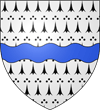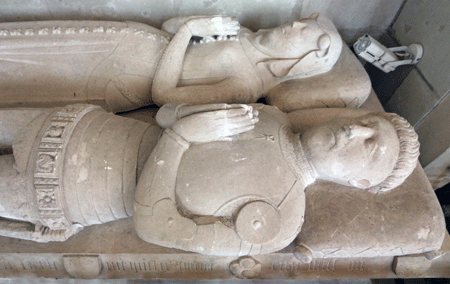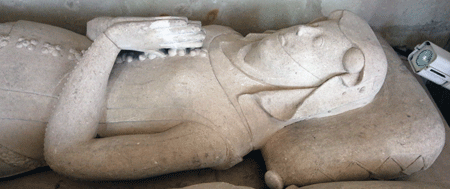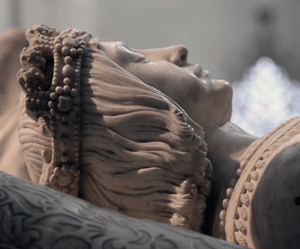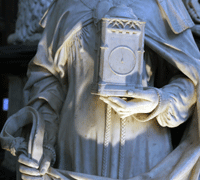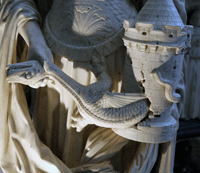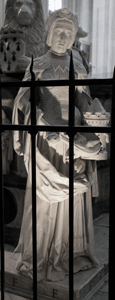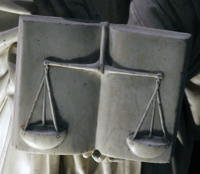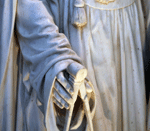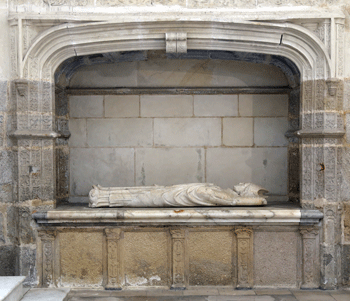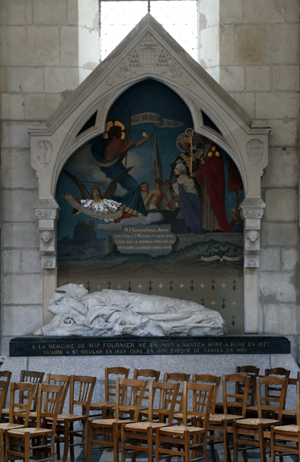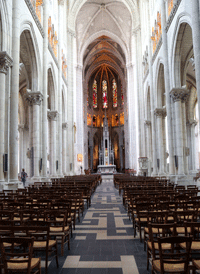 |
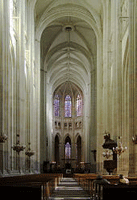 |
Cathedral Church of St
Peter & St Paul
Place St Pierre |
|
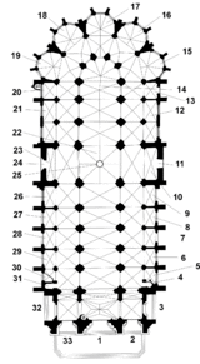 |
| The cathedral is free to
enter and photography is allowed; there is
neither shop (just a desk selling guide books)
nor refectory. There are a few guides: free
guided tours are available and entry to the
crypt is alsot. The two large tombs
complement each other by being in either of the
short transepts. There is a small platform with
stairs up so the Duke's tom can be viewed from a
higher aspect. The bishops' tombs and effigies
are in St Clair's Chapel on the south side of
the nave immediately next to the south transept.
Ref: 47° 13.07' N/
1° 32.94' W |
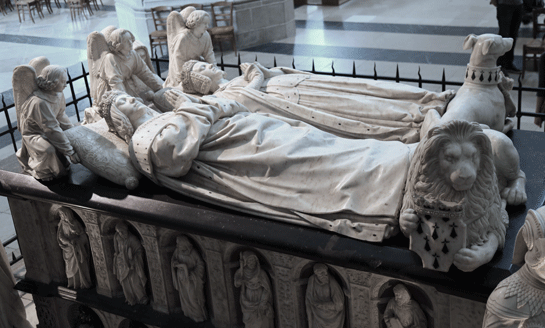 |
 |
François II, Duke
of Brittany (1488) and Marguerite de Foix
(1486).
The tomb of white (from Genoa) and black marble
(from Liège), now in the south transept, was
constructed 1502-1507 to the design the painter
Jean Perréal by sculptor Michel
Colombe, assisted by his nephew
Guillaume Regnault.
François first married Marguerite of
Brittany who died in 1469; he then married
Marguerite of Foix, who became the mother of
Anne of Brittany. His first wife had chosen the
Carmelite chapel in Nantes for her burial place
but his second wife was buried in the cathedral.
To complicate matters François wished to be
buried next to his first wife. However when Anne
of Brittany arranged to have a tomb constructed
to honour her parents, she decided it would be
place in the Carmelite chapel and not in the
cathedral and that it would contain the remains
of her father and both of his wives, although
the female effigy would be that of her mother.
After Anne's death, her heart was placed in a
gold casket and placed in the tomb, although
her body was buried in St Denis, Paris.
During the Revolution the Carmelite chapel was
demolished but fortunately the tomb was
dismantled by the architect Mathurin Crucy
to be saved and hidden. In 1817 it was reset where we
see it today. All the remains were lost but the
gold heart casket is on display in the Dobrée museum in
Nantes. It has been reported that the body of
Duke Arthur IIIof Brittany (d. 1458) had been
placed in the tomb in 1817; in fact the remains
of a Carthusian were removed from their cemetery
and placed there. I have not been able to
discover the source of this curiosity. |
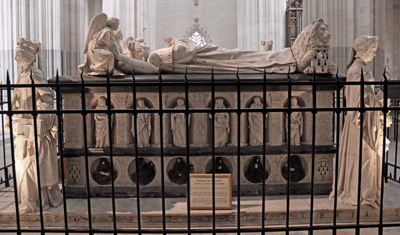 |
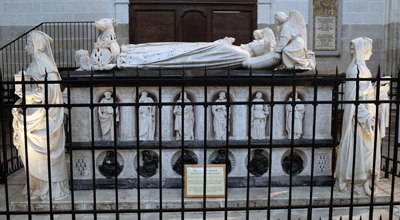 |
| Note that two single angels support
the pillows of François
and Marguerite while a third angel
supports both pillows;
the former's feet rest on lion which holds the
arms of François on a shield while the latter's
feet rest on a greyhound which holds the arms of
Brittany marshaled with Foix on a lozenge. On
the long sides of the tomb chest there are
niches containing statues of the Apostles, while
on the short side niches contain their patron
saint: St Francis of Assisi and St Margaret at
the feet and at their heads St Louis and
St Charlemagne (or Sampson, King of Brittany).
Below these figures are mourners are kneeling. |
At the angles of the tomb
chest stand the Cardinal Virtues; from left to
right above are Temperance, holding a clock and
a bridle bit, Strength, wresting a dragon from a
tower, Justice, holding a sword, scales and a
law book, and Prudence, who has two faces and
holds dividers, a hand mirror and a serpent.
These are shown centre above with various
details to their side and below.
Prudence is
said to be a portrait of Anne of Brittany
herself. (right) |
|
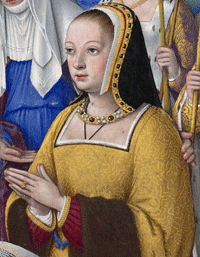 |
|
Some Notes
on François
II, Duke of Brittany |
| Duke François
II spent his reign attempting to maintain the
Duchy of Brittany independent from the French
crown. In 1488 he and his allies were defeated
by the French and François was compelled to
submit himself as a vassal of the French crown
and his ability to marry his children to a
suitor of his choosing was restricted. He died a
few months after this humiliation as a result of
a fall from his horse, leaving only one
legitimate child, Anne of Brittany, aged 12. She
was crowned Duchess of Brittany in her own right
and in attempt to maintain the independence of
her duchy was married, aged 13, by proxy to
Maximillian (Habsburg) of Austria in Rennes
cathedral. The French regarded this as an
extreme provocation: not only did it violate the
arrangement forced on her father mentioned above
but it would also lead to France being
surrounded by Hapsburg lands. In 1491 Charles
VIII invaded Brittany and forced Anne to marry
him at Langeais. |
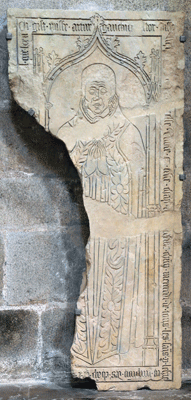 |
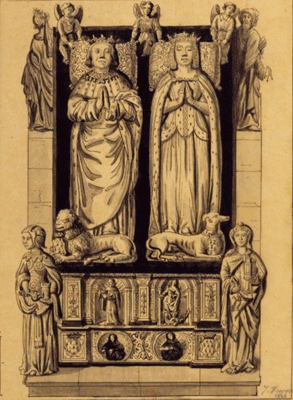 |
| Incised slab in the Sacred
Heart Chapel (Nave north) 15th century
Messire Goaud |
18th Drawing of the Brittany tomb
Despite the style and impossible perspective, an
accurate rendering |
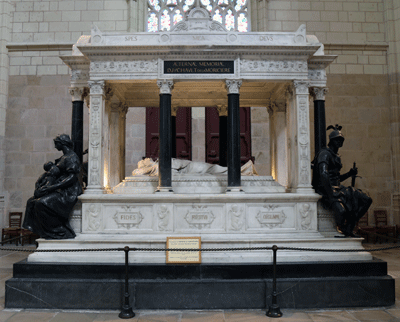 |
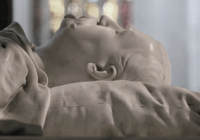 |
 |
| Cenotaph of General
Christophe de Lamoricière,
who was actually buried in the St. Philbert de
Grandlieu cemetery (Loire-Atlantique). The
cenotaph is the work of Boitte
but the recumbent effigy and angle statues are
by Paul Dubois |
 |
 |
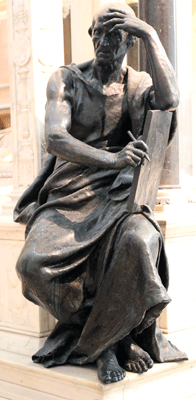 |
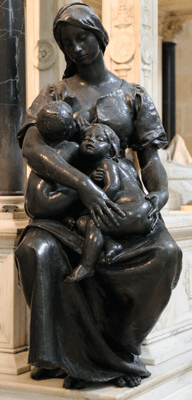 |
|
Strength, a warrior |
Faith,
a young girl praying |
Wisdom,
an old man, a scribe |
Charity, a woman with two children, breast
feeding one |
| These statues
symbolize the General's virtues. Note the two
children: the one being breast fed is an
African, the sleeping child a European. A
reference to the General's campaign in Africa. |
|
Some Notes on General Christophe de
Lamoricière (b. Nantes
1806; d. 1865) |
| Coming from a military
family Christophe de Lamoricière
joined the army as a young man. He was one of
the conquerors of Algeria and accepted the
surrender of Emir Abdelkader, the spiritual and
religious leader of the Algerians. He was much
respected by the Arabs for his skill, bravery
and polite attitude. Retiring from the army he
was elected deputy for Sarthe and was for a time
minister of war. He submitted a plan for the
free rather than military colonization of
Algeria. He was exiled for his opposition to
Napoleon III but allowed to return after six
years. He accepted command of the papal armies
defending the papal states against the
encroaching armies of the emerging liberal
Italian nation. He was defeated by the forces of
Victor Emmanuel II (first king of a united Italy
since the 7th century) against overwhelming odds
at Castelfidarda in 1860 |
|

